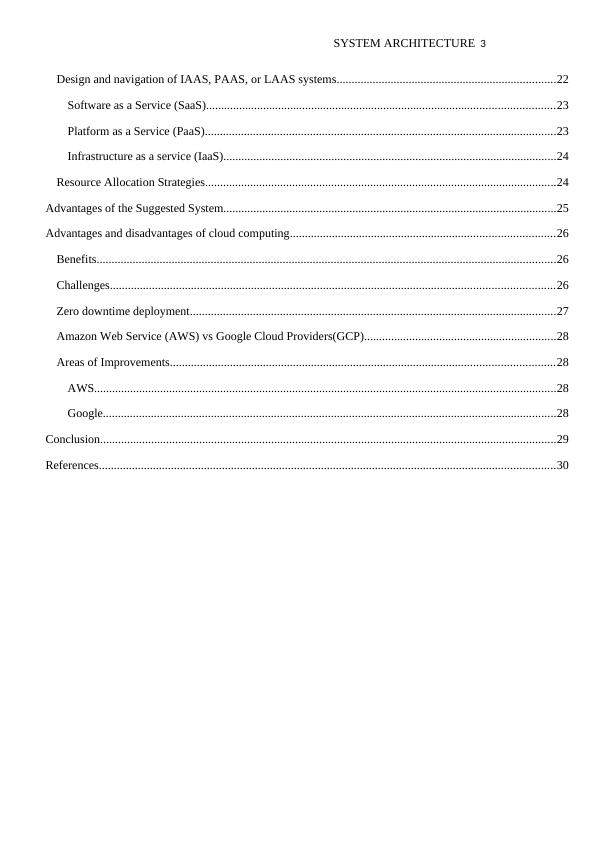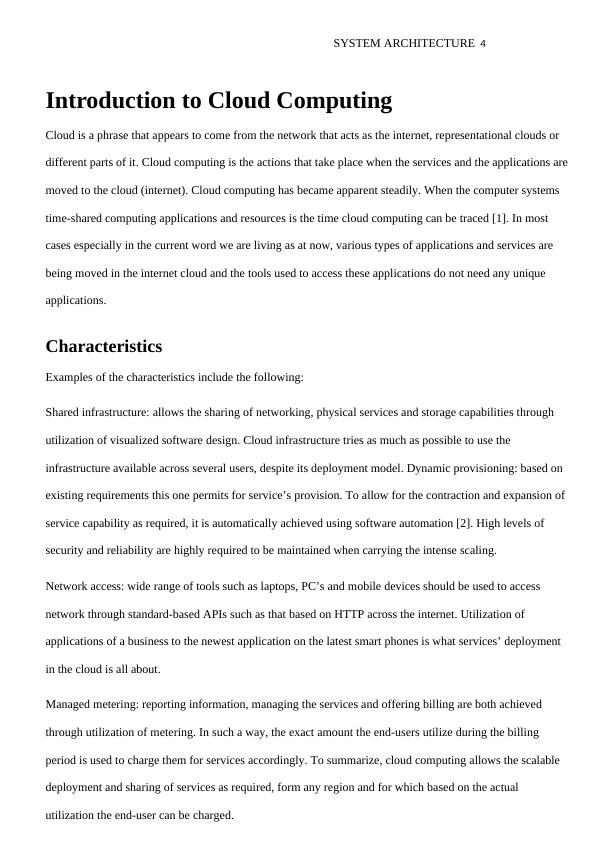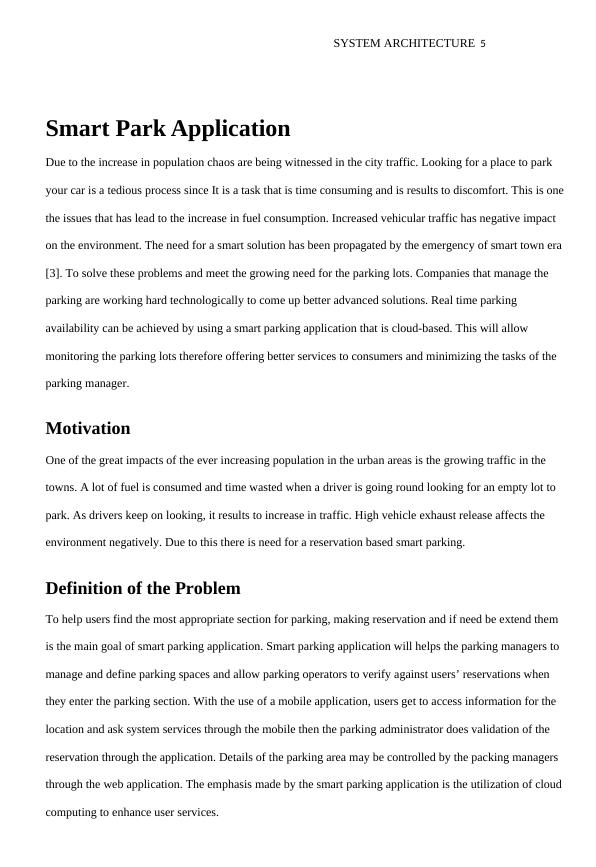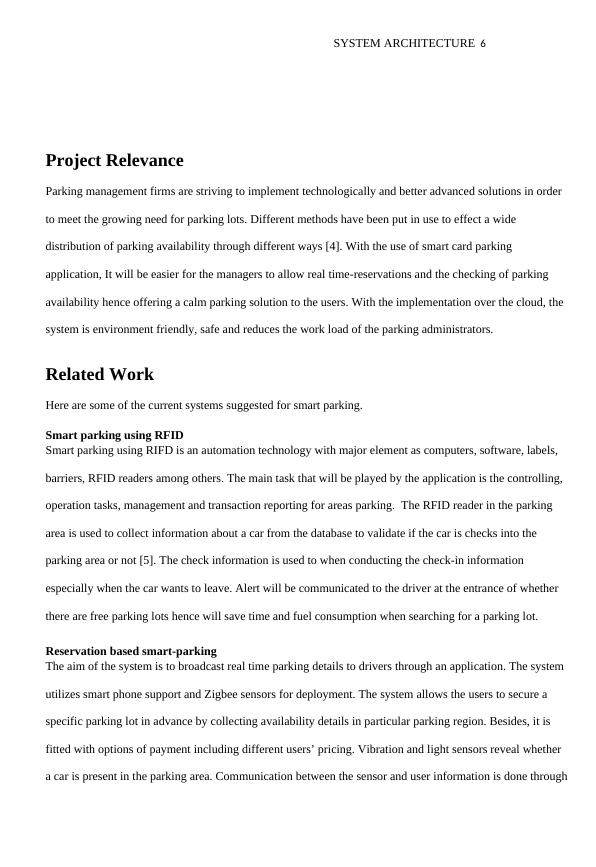Smart Park Application and Cloud Computing System Architecture
Added on 2023-06-11
30 Pages5012 Words125 Views
SYSTEM ARCHITECTURE 1
System Architecture
Student name
Course Date
System Architecture
Student name
Course Date

SYSTEM ARCHITECTURE 2
Table of Contents
Introduction to Cloud Computing......................................................................................................................4
Characteristics................................................................................................................................................4
Smart Park Application......................................................................................................................................5
Motivation......................................................................................................................................................5
Definition of the Problem...............................................................................................................................5
Project Relevance...........................................................................................................................................6
Related Work..................................................................................................................................................6
Smart parking using RFID..........................................................................................................................6
Reservation based smart-parking................................................................................................................6
Smart parking reservation system using Short Message Services (SMS)..................................................7
REQUIREMENTS.............................................................................................................................................7
Functional Requirements................................................................................................................................7
Non-functional Requirements.........................................................................................................................8
Constraints......................................................................................................................................................8
Software and hardware Requirements............................................................................................................9
Suggested Design.............................................................................................................................................10
System Architecture.....................................................................................................................................10
Abstract System Design................................................................................................................................11
Implementation.................................................................................................................................................12
Administrator website...................................................................................................................................12
Mobile Application for Operator..................................................................................................................17
Mobile Application for consumer.................................................................................................................18
Challenges of the Current System....................................................................................................................20
Results and Discussions...................................................................................................................................21
Administrator functions................................................................................................................................21
Operator functions........................................................................................................................................21
End-user functions........................................................................................................................................22
Cloud Products & Services..............................................................................................................................22
Table of Contents
Introduction to Cloud Computing......................................................................................................................4
Characteristics................................................................................................................................................4
Smart Park Application......................................................................................................................................5
Motivation......................................................................................................................................................5
Definition of the Problem...............................................................................................................................5
Project Relevance...........................................................................................................................................6
Related Work..................................................................................................................................................6
Smart parking using RFID..........................................................................................................................6
Reservation based smart-parking................................................................................................................6
Smart parking reservation system using Short Message Services (SMS)..................................................7
REQUIREMENTS.............................................................................................................................................7
Functional Requirements................................................................................................................................7
Non-functional Requirements.........................................................................................................................8
Constraints......................................................................................................................................................8
Software and hardware Requirements............................................................................................................9
Suggested Design.............................................................................................................................................10
System Architecture.....................................................................................................................................10
Abstract System Design................................................................................................................................11
Implementation.................................................................................................................................................12
Administrator website...................................................................................................................................12
Mobile Application for Operator..................................................................................................................17
Mobile Application for consumer.................................................................................................................18
Challenges of the Current System....................................................................................................................20
Results and Discussions...................................................................................................................................21
Administrator functions................................................................................................................................21
Operator functions........................................................................................................................................21
End-user functions........................................................................................................................................22
Cloud Products & Services..............................................................................................................................22

SYSTEM ARCHITECTURE 3
Design and navigation of IAAS, PAAS, or LAAS systems.........................................................................22
Software as a Service (SaaS)....................................................................................................................23
Platform as a Service (PaaS).....................................................................................................................23
Infrastructure as a service (IaaS)...............................................................................................................24
Resource Allocation Strategies.....................................................................................................................24
Advantages of the Suggested System...............................................................................................................25
Advantages and disadvantages of cloud computing........................................................................................26
Benefits.........................................................................................................................................................26
Challenges....................................................................................................................................................26
Zero downtime deployment..........................................................................................................................27
Amazon Web Service (AWS) vs Google Cloud Providers(GCP)................................................................28
Areas of Improvements................................................................................................................................28
AWS..........................................................................................................................................................28
Google.......................................................................................................................................................28
Conclusion........................................................................................................................................................29
References........................................................................................................................................................30
Design and navigation of IAAS, PAAS, or LAAS systems.........................................................................22
Software as a Service (SaaS)....................................................................................................................23
Platform as a Service (PaaS).....................................................................................................................23
Infrastructure as a service (IaaS)...............................................................................................................24
Resource Allocation Strategies.....................................................................................................................24
Advantages of the Suggested System...............................................................................................................25
Advantages and disadvantages of cloud computing........................................................................................26
Benefits.........................................................................................................................................................26
Challenges....................................................................................................................................................26
Zero downtime deployment..........................................................................................................................27
Amazon Web Service (AWS) vs Google Cloud Providers(GCP)................................................................28
Areas of Improvements................................................................................................................................28
AWS..........................................................................................................................................................28
Google.......................................................................................................................................................28
Conclusion........................................................................................................................................................29
References........................................................................................................................................................30

SYSTEM ARCHITECTURE 4
Introduction to Cloud Computing
Cloud is a phrase that appears to come from the network that acts as the internet, representational clouds or
different parts of it. Cloud computing is the actions that take place when the services and the applications are
moved to the cloud (internet). Cloud computing has became apparent steadily. When the computer systems
time-shared computing applications and resources is the time cloud computing can be traced [1]. In most
cases especially in the current word we are living as at now, various types of applications and services are
being moved in the internet cloud and the tools used to access these applications do not need any unique
applications.
Characteristics
Examples of the characteristics include the following:
Shared infrastructure: allows the sharing of networking, physical services and storage capabilities through
utilization of visualized software design. Cloud infrastructure tries as much as possible to use the
infrastructure available across several users, despite its deployment model. Dynamic provisioning: based on
existing requirements this one permits for service’s provision. To allow for the contraction and expansion of
service capability as required, it is automatically achieved using software automation [2]. High levels of
security and reliability are highly required to be maintained when carrying the intense scaling.
Network access: wide range of tools such as laptops, PC’s and mobile devices should be used to access
network through standard-based APIs such as that based on HTTP across the internet. Utilization of
applications of a business to the newest application on the latest smart phones is what services’ deployment
in the cloud is all about.
Managed metering: reporting information, managing the services and offering billing are both achieved
through utilization of metering. In such a way, the exact amount the end-users utilize during the billing
period is used to charge them for services accordingly. To summarize, cloud computing allows the scalable
deployment and sharing of services as required, form any region and for which based on the actual
utilization the end-user can be charged.
Introduction to Cloud Computing
Cloud is a phrase that appears to come from the network that acts as the internet, representational clouds or
different parts of it. Cloud computing is the actions that take place when the services and the applications are
moved to the cloud (internet). Cloud computing has became apparent steadily. When the computer systems
time-shared computing applications and resources is the time cloud computing can be traced [1]. In most
cases especially in the current word we are living as at now, various types of applications and services are
being moved in the internet cloud and the tools used to access these applications do not need any unique
applications.
Characteristics
Examples of the characteristics include the following:
Shared infrastructure: allows the sharing of networking, physical services and storage capabilities through
utilization of visualized software design. Cloud infrastructure tries as much as possible to use the
infrastructure available across several users, despite its deployment model. Dynamic provisioning: based on
existing requirements this one permits for service’s provision. To allow for the contraction and expansion of
service capability as required, it is automatically achieved using software automation [2]. High levels of
security and reliability are highly required to be maintained when carrying the intense scaling.
Network access: wide range of tools such as laptops, PC’s and mobile devices should be used to access
network through standard-based APIs such as that based on HTTP across the internet. Utilization of
applications of a business to the newest application on the latest smart phones is what services’ deployment
in the cloud is all about.
Managed metering: reporting information, managing the services and offering billing are both achieved
through utilization of metering. In such a way, the exact amount the end-users utilize during the billing
period is used to charge them for services accordingly. To summarize, cloud computing allows the scalable
deployment and sharing of services as required, form any region and for which based on the actual
utilization the end-user can be charged.

SYSTEM ARCHITECTURE 5
Smart Park Application
Due to the increase in population chaos are being witnessed in the city traffic. Looking for a place to park
your car is a tedious process since It is a task that is time consuming and is results to discomfort. This is one
the issues that has lead to the increase in fuel consumption. Increased vehicular traffic has negative impact
on the environment. The need for a smart solution has been propagated by the emergency of smart town era
[3]. To solve these problems and meet the growing need for the parking lots. Companies that manage the
parking are working hard technologically to come up better advanced solutions. Real time parking
availability can be achieved by using a smart parking application that is cloud-based. This will allow
monitoring the parking lots therefore offering better services to consumers and minimizing the tasks of the
parking manager.
Motivation
One of the great impacts of the ever increasing population in the urban areas is the growing traffic in the
towns. A lot of fuel is consumed and time wasted when a driver is going round looking for an empty lot to
park. As drivers keep on looking, it results to increase in traffic. High vehicle exhaust release affects the
environment negatively. Due to this there is need for a reservation based smart parking.
Definition of the Problem
To help users find the most appropriate section for parking, making reservation and if need be extend them
is the main goal of smart parking application. Smart parking application will helps the parking managers to
manage and define parking spaces and allow parking operators to verify against users’ reservations when
they enter the parking section. With the use of a mobile application, users get to access information for the
location and ask system services through the mobile then the parking administrator does validation of the
reservation through the application. Details of the parking area may be controlled by the packing managers
through the web application. The emphasis made by the smart parking application is the utilization of cloud
computing to enhance user services.
Smart Park Application
Due to the increase in population chaos are being witnessed in the city traffic. Looking for a place to park
your car is a tedious process since It is a task that is time consuming and is results to discomfort. This is one
the issues that has lead to the increase in fuel consumption. Increased vehicular traffic has negative impact
on the environment. The need for a smart solution has been propagated by the emergency of smart town era
[3]. To solve these problems and meet the growing need for the parking lots. Companies that manage the
parking are working hard technologically to come up better advanced solutions. Real time parking
availability can be achieved by using a smart parking application that is cloud-based. This will allow
monitoring the parking lots therefore offering better services to consumers and minimizing the tasks of the
parking manager.
Motivation
One of the great impacts of the ever increasing population in the urban areas is the growing traffic in the
towns. A lot of fuel is consumed and time wasted when a driver is going round looking for an empty lot to
park. As drivers keep on looking, it results to increase in traffic. High vehicle exhaust release affects the
environment negatively. Due to this there is need for a reservation based smart parking.
Definition of the Problem
To help users find the most appropriate section for parking, making reservation and if need be extend them
is the main goal of smart parking application. Smart parking application will helps the parking managers to
manage and define parking spaces and allow parking operators to verify against users’ reservations when
they enter the parking section. With the use of a mobile application, users get to access information for the
location and ask system services through the mobile then the parking administrator does validation of the
reservation through the application. Details of the parking area may be controlled by the packing managers
through the web application. The emphasis made by the smart parking application is the utilization of cloud
computing to enhance user services.

SYSTEM ARCHITECTURE 6
Project Relevance
Parking management firms are striving to implement technologically and better advanced solutions in order
to meet the growing need for parking lots. Different methods have been put in use to effect a wide
distribution of parking availability through different ways [4]. With the use of smart card parking
application, It will be easier for the managers to allow real time-reservations and the checking of parking
availability hence offering a calm parking solution to the users. With the implementation over the cloud, the
system is environment friendly, safe and reduces the work load of the parking administrators.
Related Work
Here are some of the current systems suggested for smart parking.
Smart parking using RFID
Smart parking using RIFD is an automation technology with major element as computers, software, labels,
barriers, RFID readers among others. The main task that will be played by the application is the controlling,
operation tasks, management and transaction reporting for areas parking. The RFID reader in the parking
area is used to collect information about a car from the database to validate if the car is checks into the
parking area or not [5]. The check information is used to when conducting the check-in information
especially when the car wants to leave. Alert will be communicated to the driver at the entrance of whether
there are free parking lots hence will save time and fuel consumption when searching for a parking lot.
Reservation based smart-parking
The aim of the system is to broadcast real time parking details to drivers through an application. The system
utilizes smart phone support and Zigbee sensors for deployment. The system allows the users to secure a
specific parking lot in advance by collecting availability details in particular parking region. Besides, it is
fitted with options of payment including different users’ pricing. Vibration and light sensors reveal whether
a car is present in the parking area. Communication between the sensor and user information is done through
Project Relevance
Parking management firms are striving to implement technologically and better advanced solutions in order
to meet the growing need for parking lots. Different methods have been put in use to effect a wide
distribution of parking availability through different ways [4]. With the use of smart card parking
application, It will be easier for the managers to allow real time-reservations and the checking of parking
availability hence offering a calm parking solution to the users. With the implementation over the cloud, the
system is environment friendly, safe and reduces the work load of the parking administrators.
Related Work
Here are some of the current systems suggested for smart parking.
Smart parking using RFID
Smart parking using RIFD is an automation technology with major element as computers, software, labels,
barriers, RFID readers among others. The main task that will be played by the application is the controlling,
operation tasks, management and transaction reporting for areas parking. The RFID reader in the parking
area is used to collect information about a car from the database to validate if the car is checks into the
parking area or not [5]. The check information is used to when conducting the check-in information
especially when the car wants to leave. Alert will be communicated to the driver at the entrance of whether
there are free parking lots hence will save time and fuel consumption when searching for a parking lot.
Reservation based smart-parking
The aim of the system is to broadcast real time parking details to drivers through an application. The system
utilizes smart phone support and Zigbee sensors for deployment. The system allows the users to secure a
specific parking lot in advance by collecting availability details in particular parking region. Besides, it is
fitted with options of payment including different users’ pricing. Vibration and light sensors reveal whether
a car is present in the parking area. Communication between the sensor and user information is done through

End of preview
Want to access all the pages? Upload your documents or become a member.
Related Documents
Cloud Based Smart Application Managementlg...
|12
|2960
|142
Cloud Computing: Benefits and Issues for GTGOVlg...
|12
|1331
|96
Evaluate Cloud Architecturelg...
|11
|1697
|300
Migration of DTGOV to Cloud Computinglg...
|12
|844
|56
Implementation of Cloud Computing in Regional Gardenslg...
|13
|639
|290
System Architecture: Cloud-Based Smart Home Management Systemlg...
|7
|1578
|183
